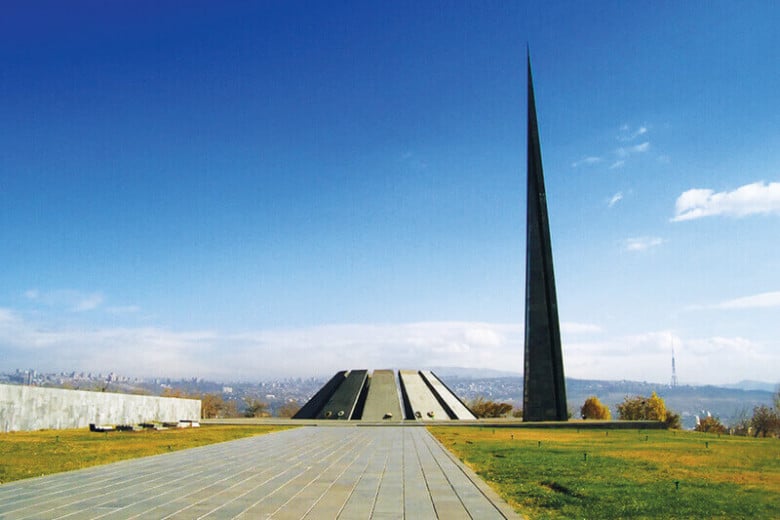Yerevan

Yerevan has been the capital of Armenia since 1918. It s the administrative, cultural, economic and industrial center of the country. Yerevan is considered to be one of the oldest cities in the world. According to historical data, Yerevan is 29 years older than Rome.
It was founded by Argishti 1st in 782 B.C. and was named Erebuni. Now the Erebuni Museum is located on the ruins of the ancient fortress city. According to the legend, after Noah’s Ark landed on Mountain Ararat, the first dry place that Noah noticed was this land. He exclaimed: "Yerevats" ("it appeared!") and from that day the place was called Yerevan. However, the name of the city of Yerevan goes back to the period of Urartu and originates from the name "Erebuni"
Places of Interest in Yerevan
Yerevan is the cultural center of Armenia. It is home to a large number of museums, art galleries, theatres, and libraries. The most prominent of these are the Matenadaran library-museum of ancient manuscripts, the Armenian Genocide Museum of Tsitsernakaberd complex, the Cafesjian Museum of Art, the National Gallery and the History Museum of Armenia. The latter two share the beautiful head building of the Republic Square of Yerevan. The famous "singing" fountains in front of the National Gallery make the view of the building, and of the square in general, even more spectacular.
Matenadaran
The Mesrop Mashtots Institute of Ancient Manuscripts also known as Matenadaran is a depository of ancient manuscripts and possesses the world's largest collection of Armenian manuscripts. It was founded in 1959 in Yerevan. The repository contains more than 17000 manuscripts, 450 thousand documents, and 3000 ancient books. The oldest manuscript is the “Vehamor Avetaran” which has been kept from the 8th century. Here you will see the biggest Armenian book “Msho Charyntir” (28 kg) and the smallest one weighing 190g.
Tsitsernakaberd
Another important place for Armenians is Tsitsernakaberd Memorial Complex. It is dedicated to the victims of the Armenian Genocide. The Memorial Complex was built in 1967 in Yerevan. It also includes the Armenian Genocide Museum-Institute which was opened in 1995.

Churches in Yerevan
You can find a lot of churches in the “pink city”; every district has its own church. The Saint Gregory the Illuminator Cathedral is the largest Armenian Apostolic Church in Armenia. It is located in the central part of Yerevan. The designer was the famous architect Stepan Kurkchyan.
Zoravar Surb Astvatsatsin is one of the oldest churches in Yerevan. It is located in the oldest part of the city which was called Shahar district. The tomb and the Chapel of Ananias the Apostle were located here. Once the chapel was a famous sanctuary. The church changed its name to Zoravar because in the 13th century it was home to a bible of Zoravor. The church is located in the Kentron (central) district of modern Yerevan.
Katoghike Holy Mother of God is a small medieval church located in the Kentron District of Yerevan. There is a carved script on one of the walls of Katoghike which dates back to 1264. The church was seriously affected by an earthquake in 1679. Later a large basilica named after the Holy Mother of God was built around the Katoghike church and was demolished in 1936. Only during the demolition, the Katoghike church was discovered hidden in the walls of the basilica. Khachkars found in the wall during the demolition date back to the 15th and 17th centuries.
Saint Sarkis Church was built in 1842. It is located on the left bank of the Hrazdan River.

Once it was a huge monastery complex surrounded by high gates which included three churches: St Sarkis, St Gevorg, and St Hakob. Saint Sarkis Church was the official seat of the Patriarch and the monastery was a patriarchal residence for guests. Unfortunately, the two churches were destroyed during the 1679 earthquake, and later only St Sarkis was rebuilt. Nowadays, it is the seat of the Araratian Pontifical Diocese of the Armenian Apostolic Church.
Theatres
Yerevan is also famous for its theatres, cinemas and other cultural centers. The building of Opera and Ballet Theatre is one of the main symbols of the city.. At night when the street lights and the lights of the buildings are on, the city reveals its real beauty. One can roam for hours at the peaceful nights of Yerevan and discover the city in your own way.
Parks in Yerevan
Yerevan has many green areas and parks where you can just take a walk and enjoy yourself. One of them is Haghtanaki Zbosaygi, which is dedicated to the victory in the Second World War. The most impressive statue of the Armenian architecture, Mother Armenia is situated in this park.
Another special park in Yerevan is located not far from the Opera and Ballet House, which is named after the great Armenian painter Martiros Saryan. Here you will find an open-air exhibition of the works of modern painters․ Nearly every day the artists gather in the park around statue of Saroyan to display and sell their pictures.

Weather
Residents of the capital know that with the arrival of spring it's already warm in Yerevan. Weather in Yerevan is sunny almost 365 days a year. The average temperature is +25 in summer (sometimes rising even up to +43), and -4/-5 in winter. Summer in Yerevan lasts more than 4 months. Winters are short and warm. As you can see our pink capital is just a dream for both tourists and locals.
Sights
History Museum of Armenia
The History Museum of Armenia was founded in 1919. It exhibits about 400,000 art crafts of the Armenian Highlands from the prehistoric times to the middle ages and our days.
Read More



























